
The Nose Knows
What's in the Story?
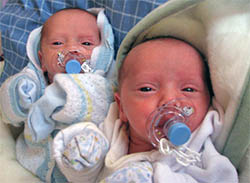
If you’ve ever met a pair of identical twins, you know how difficult it can be to tell them apart. Sure, after some time you may begin to notice subtle differences, which you can use to tell the twins apart. But, at times, it may still be hard to distinguish between the two.
Most likely you are relying on your eyes and/or ears to reveal slight differences in facial features or voice patterns. It is unlikely that you would choose to rely on differences in the twins’ scents. Doesn’t it seem odd to consider smelling two people in order to tell them apart? It might seem funny for people to do this, but dogs rely on their noses as their finest tool for identifying people.
In the PLOS ONE article, “Dogs Discriminate Identical Twins,” scientists performed experiments to determine whether or not identical genetics led to identical scents. Could a dog’s nose reliably smell the difference between identical twins?
What’s So Special About Identical Twins Anyway?
In science, “identical” twins are often referred to as monozygotic. But, more commonly, monozygotic twins are called “identical” because they appear to be, well, identical.
But, there really is more to it than just how these twins look….
Identical twins are special because they share the exact same DNA. Imagine DNA as being a design for a car. Most of the cars you see have similar designs, but they are still unique or easy to tell apart from other cars on the road. Though, every once in a while you see two cars that seem to be exactly the same. These two cars must have had the same design, so they should be identical in every way, right? Not exactly… These two cars will have small differences as they are built and ultimately will have two separate drivers changing their fates. So, if we go back to identical human twins, how do we determine exactly what these differences may be?

To answer a question like this, first, scientists choose a phenotype of interest. Then they can ask a question about the phenotype and design an experiment to answer the question. In this article, the phenotype of interest was body scent.
If a dog were well-trained in scent identification, would this dog be able to tell the difference between a pair of genetically identical twins? What do you think?
So, How Did They Figure It Out?
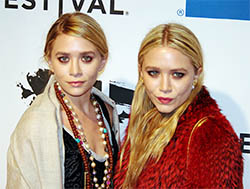
Scientists chose 10 well-trained police dogs and two sets of human monozygotic twins. It was important that the twins lived in the same environment and that they ate the same foods. This is because a person’s home environment and the foods that he or she eats can influence the scent of his or her body. Have you ever smelled someone after they have eaten a lot of stinky garlic?
Once participants had been chosen, scent samples were collected and labeled. The two pairs of monozygotic twins were labeled to avoid confusion. Set 1 was labeled as Twin 1A and Twin 1B, and set 2 was labeled as Twin 2A and Twin 2B. This information will come in handy later.
Each twin wore a piece of cotton on their belly for 20 minutes in order to allow the cotton to fully absorb each twin’s personal scent. These pieces of cotton were then placed in sealed jars where they could later be identified by the dogs.
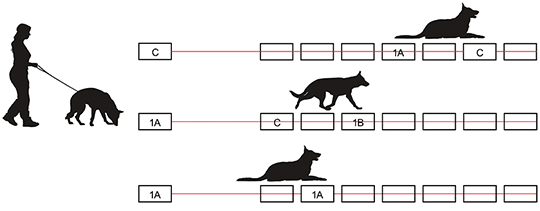
To test the dogs, scientists created an experiment involving a “scent identification line-up”. This set-up was used because the police dogs were familiar with this type of test.
The dog would first smell a sample of the “target scent”. Then the dog would be sent to search for the jar which contained the correct “matching scent”. When the dog reached the jar with the matching scent, the dog would lay down to signal that they had matched the scent. Pretty simple, right?
Well, these scents were harder to identify than the scents the dogs were used to identifying. This is because some of the line-ups contained scents that were meant to “trick” the dogs. These tricky line-ups contained scents of both twins in the set. For example: If the “target scent” was the scent of Twin 1A, the line-up contained scents from both Twin 1A and from Twin 1B. These twin scents would be almost identical, so the dog would have to be very careful not to choose the wrong scent.
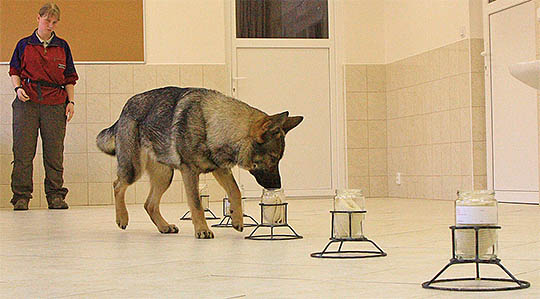
What Did The Scientists Find?
All 10 of the dogs were able to tell the difference between the scents of the monozygotic twins. Each dog had to perform 60 separate scent identification line-ups and each dog received a perfect score. Isn’t it exciting when you take a test and receive a perfect score? It is exciting for scientists too, because it means that the results were not just luck.
What Does This Mean?
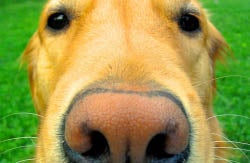
This study had two main questions:
- Can dogs tell the difference between identical twins' body scents?
- If so, which dogs can tell apart identical twins body scents?
The scientists designed this experiment with a few guiding ideas. These ideas were:
- Past experiments were unsuccessful because the dogs being used had different levels of training
- If a new experiment used dogs which had the highest level of training, then all of these dogs would successfully be able to tell the twins apart
Scientists discovered that a well-trained dog’s nose can tell the difference between two identical twins. Identical twins do not have identical scents even if the twins live in identical environments and eat identical foods.
Where to learn more about this topic:
Wikipedia - Introduction to Genetics
Wikipedia - Information about identical twins vs. fraternal twins
Additional images from Wikimedia. Mary Kate and Ashley Olsen image from David Shankbone via Wikimedia.
Bibliographic details:
- Article: The Nose Knows
- Author(s): Stephanie Outlaw
- Publisher: Arizona State University School of Life Sciences Ask A Biologist
- Site name: ASU - Ask A Biologist
- Date published:
- Date accessed:
- Link: https://askabiologist.asu.edu/plosable/nose-knows
APA Style
Stephanie Outlaw. (). The Nose Knows. ASU - Ask A Biologist. Retrieved from https://askabiologist.asu.edu/plosable/nose-knows
Chicago Manual of Style
Stephanie Outlaw. "The Nose Knows". ASU - Ask A Biologist. . https://askabiologist.asu.edu/plosable/nose-knows
Stephanie Outlaw. "The Nose Knows". ASU - Ask A Biologist. . ASU - Ask A Biologist, Web. https://askabiologist.asu.edu/plosable/nose-knows
MLA 2017 Style

These sisters are identical twins. Can you tell them apart?
Be Part of
Ask A Biologist
By volunteering, or simply sending us feedback on the site. Scientists, teachers, writers, illustrators, and translators are all important to the program. If you are interested in helping with the website we have a Volunteers page to get the process started.
